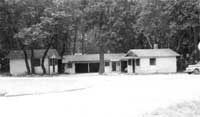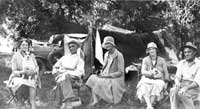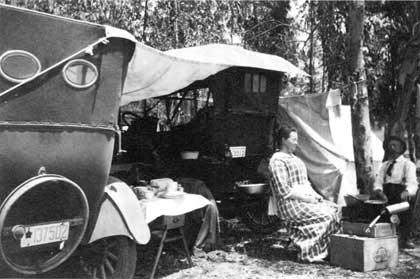Save the Auto Camps!
by Stephen Mark
In the mid-1800s. roads and water routes were the two ways of transporting goods and travelers during the Euro-American settlement of the Pacific Northwest. Hotels, in the modern sense of the word, developed as the accompaniment to the convenient transportation systems represented by the railroads. As the number of cars increased in the Pacific Northwest after 1905, so, too, did the need for accommodations for auto enthusiasts. The first half of this century saw the rise and fall of auto camps. Today, lacking protection from the National Register of Historic Places, these historic sites are rapidly disappearing.
|
Some automobile owners viewed themselves as pioneers and reveled in their ability to camp on the outskirts of towns or anywhere along a road. ca 1927, Courtesy Southern Oregon Historical Society #15051 |
The auto camping fad peaked between 1915 and 1922. Spurred, in part, by the fear of breaking down on poor roads, possibly miles from any town with a hotel, travelers began outfitting their vehicles with camping equipment. Some automobile owners viewed themselves as pioneers and reveled in their ability to camp on the outskirts of towns, or anywhere along the road. Camping was also inexpensive, and many vacation destinations offered no other type of accommodation.
The early auto campers often avoided hotels, even though most could easily afford the rates. By camping, the auto “gypsy” did not have to make reservations, or eat at the times set by the hotel dining rooms. He did not have to tip, nor explain his sometimes disheveled appearance after a day on the road to a clerk in a hotel lobby. In camping there was room for a tourist’s family, easy access to his vehicle (most hotels did not have their own parking until after World War II), informality, and fresh air. [1]
Even before the Pacific Highway opened in 1913 as a route connecting cities located in the region’s western interior valleys, auto camping had been done on a short-term basis in many towns. Campers in Ashland were allowed to occupy the city park for a couple of weeks each summer for the Chautauqua festivities. By 1910, auto campers were the natural successors to the earlier attendees brought to town by wagon. [2] Lithia Park Auto Court ca 1940
Lithia Park Auto Court ca 1940
Courtesy Southern Oregon Historical Society #15988
 Left to right: Minnie Lane, Mr. and Mrs. Pernell Whitmore, Jessie Stone and Clarence lane at Diamond Lake. Their two pets are Patsy Ruth and Skippy Stone. June 1931, Courtesy Southern Oregon Historical Society #15035
Left to right: Minnie Lane, Mr. and Mrs. Pernell Whitmore, Jessie Stone and Clarence lane at Diamond Lake. Their two pets are Patsy Ruth and Skippy Stone. June 1931, Courtesy Southern Oregon Historical Society #15035
Problems associated with unrestricted camping justified the establishment and subsidization of free municipal auto camps. The first official municipal camp in the United States appeared in Douglas, Arizona. in 1913. [3]
Within two years, several cities in the Pacific Northwest wanted to cash in on the number of affluent auto tourists passing through their communities. Boosters looked to the town’s park board to situate an auto camp in a centrally located city park. They reasoned that this would attract tourists to downtown stores and allow the town to advertise itself as one which embraced progress. [4]


